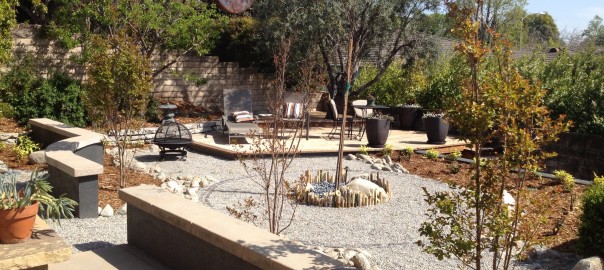April 7, 2015
The whole great State of California has a mandate to reduce water use by 25%. Although it is going to be diffuclt, we can easily achieve this–stop watering our lawns. This will be a massive savings of water since about 9 out of 10 homeowners have lawn.
The design aspect of having a lawn, may seem simple, but that is because it is over used. The real issue is complex. First of all, lawns are a necesary evil, especially if you have children, pets or enjoy outdoor activities. There is nothing like grass to take foot traffic. So, not all lawns are objectable. The issue is how we have all used grass as a ground cover, millions and millions of Californians. I say, if the only person who walks on your lawn is the gardener, then let that lawn go! A lawn should be no more than 30% of your total gardening space. As we are in a dought I would reduce that number by half. We must sacrifice, there is no choice. I also object to municipal medians and parkways that use grass as a ground cover. Again, if the only person who walks on it is the gardener—-let it go!
At Indah Bulan, we tend to always remove lawns except where useful . Here are some alternatives to having a lawn or lawn substitutes.
- Red Fescue (Festuca rubrum) This is a California native grass that grows well with little water.
- Mulch…. until you can figure out what to do, simply much the dead lawn.
- For areas to be used for entertaining, use pavers set in gravel. This will allow the water to percolate back into the ground, create a pattern and most importantly define an area with style.
- Succulents, these can be planted year round and enjoy being dry. Most tend to be more colorful with dry heat.
- Plant a Grove of Trees… fill your old lawn area with trees, turn it into a woodland.
- Create a path and planting areas. This creates a garden that has visual interest and practicality if the paths are well thought out.
- Evergreen Ground Covers. There are hundreds of choices. If you want a look to replicate grass, choose a plant with small leaves. A really good choice is Achillea milliafolium. It is a low growning yarrow, that can take some foot traffic, being mowed, and has a flower.
- Create a riparian area with native rocks, trees, shrubs and design.
- Create a planting design that uses mass plantings of a single variety of low shrub(s).
- Do nothing until you have a plan. Mow the grass down as low to the ground as possble, stop watering and take time to dream. Use the drought to solve a problem thoughtfully.
There really are so many wonderful options. When we design a garden for clients, we choose what is best for them, the architecture of their home and how they want to use it. This is a great opportunity to create something that is special, practical, sustainable and gorgeous.
Stephen Swafford, Landscape Architect
INDAH BULAN

